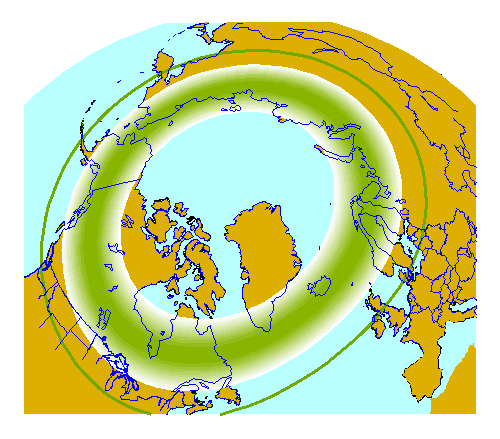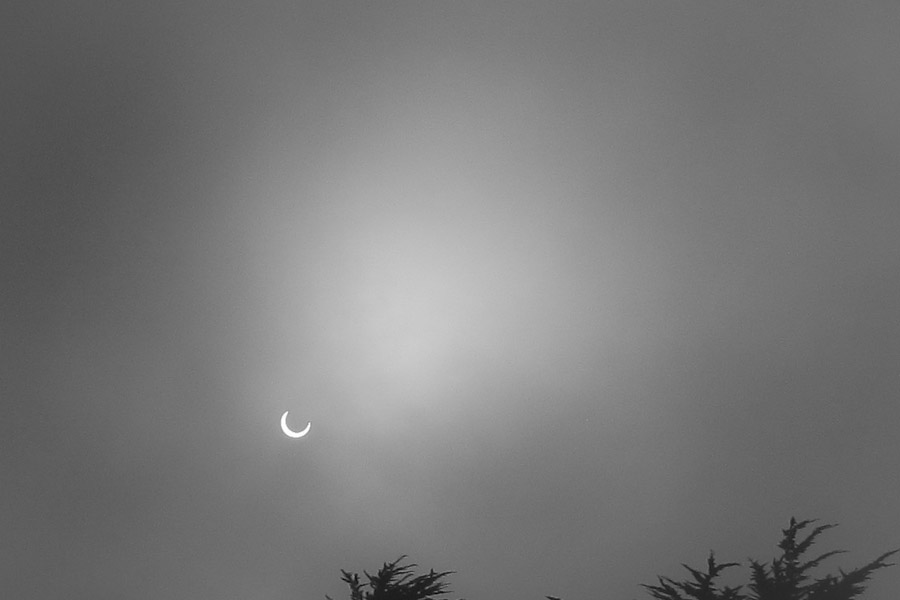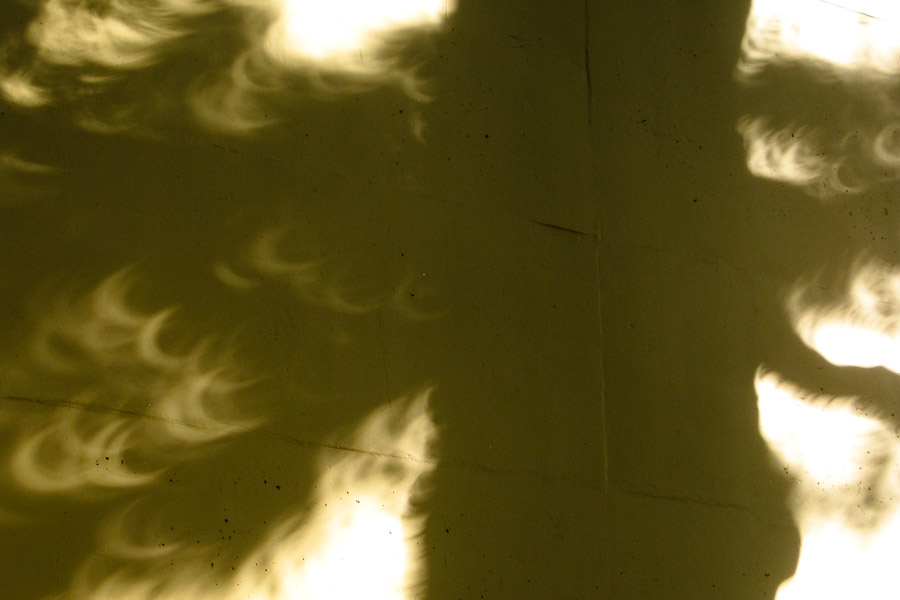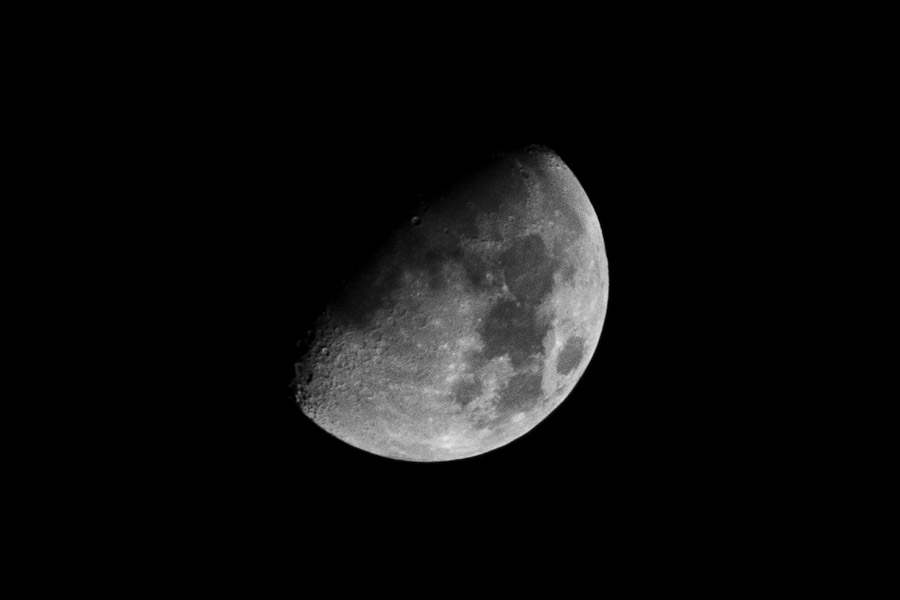The aurora borealis could be visible as far south as Chicago, Belfast, and Seattle tonight and tomorrow:

A significant event located on the Sun facing Earth took place on July 12. The effects of this event will begin to reach Earth early on the 14th of July GMT.
Observers in North America should watch for aurora on the nights of the 14th and 15th local time. Depending on the configuration of the disturbance, auroras may be visible as far south as the middle tier of states.
Activity may remain high also on the 16th. Auroras should be visible Southern New Zealand, Tasmania, and of course, Antarctica.
I've only seen aurorae from airplanes in flight over the polar regions. Obviously they're invisible from within the city of Chicago, but if I had a boat, tonight would be great for going out on the lake and looking for them.
This evening's eclipse, through clouds:

Also visible in the shadows:

An hour later, it's a lot brighter out.
But only if you're near the Pacific:
The midwest might not have the best view but the annular solar eclipse will at least be partially visible from here. The southwest will have the best vantage point when the sun appears as a "ring of fire" when the moon passes between it and the earth on Sunday. The moon will cover about 95% of the sun's diameter during this event. The eclipse will follow a path 8500 miles long for about 3 and a half hours. The "ring of fire" spectacle will last up to 5 minutes depending on the vantage point. Six national parks in the west, including Redwoods National Park in California and Zion National Park in Utah, are enticing visitors by offering some of the best views since the eclipse track will drift right over the parks.
The eclipse starts in San Francisco at 17:16 PDT, reaches its maximum at 18:33, and ends at 19:40. Here's a map from the University of Manitoba:

Remember, don't look at the eclipse directly. It's an annular eclipse, so it will be dangerously bright if you look straight at it.
Update: NASA has an information page about this event.
Researchers at Amundsen-Scott South Pole Station have been watching the sun set for weeks. At the poles, the sun traces an excruciatingly slow corkscrew between equinoxes, first spiraling up to a point 23° above the horizon (only about as high as the sun gets in Chicago around 10am on December 21st) on the solstice, then slowly spiraling back down to the horizon over the next three months.
In about an hour from now, the last limb of the sun will slip below the south polar horizon, the twilight gradually fading for another three weeks. The sun won't appear again until September 20th.
Fourteen people will spend the next five months at Amundsen-Scott, with no possibility of leaving until the end of August.
I've never felt great about the Daylight Saving Time switch happening in the beginning of March, but here it is. Oddly, I have no trouble changing eleven or twelve time zones, but the one-hour change in the spring (but not the fall) always messes me up.
Anyway, if you live in the U.S. or Canada (excluding Arizona and Saskatchewan), it's probably an hour later than you think it is.
In general, people using words they don't understand, presumably to sound smart, drives me up a tree. In specific, I wish against reason that more people knew how time zones worked. Microsoft's Raymond Chen agrees:
One way of sounding official is to give the times during which the outage will take place is a very formal manner. "The servers will be unavailable on Saturday, March 17, 2012 from 1:00 AM to 9:00 AM Pacific Standard Time."
Did you notice something funny about that announcement?
On March 17, 2012, most of the United States will not be on Standard Time. They will be on Daylight Time. (The switchover takes place this weekend.)
Now, I'm one of the few people in the world who has implemented a complete time zone package for Windows systems, and regular readers will already know about my vocal defense of the Olson/IANA time zone database. So I don't expect most people to know the ins and outs of time zone abbreviations. But this is the point Chen makes, and I would like to make: if you don't know what you're writing, don't write it. Say "Central time" or "local Chicago time" instead of "Central Standard Time," if for no other reason than you'll be wrong about the latter 8 months out of the year.
At this time of year, people from the tropics to the poles really become aware of changes in the lengths of the days. Yesterday Chicago had 11 hours of daylight for the first time since October 18th; we get 12 hours of daylight less than three weeks from now. Tuesday the sun set at 5:30pm for the first time since standard time returned on November 5th; it sets at 7pm on March 16th.
From the solstice through February 1st we only get about one additional hour of daylight (though, because of the Earth's orbit, most of it comes in the evening). But the really dramatic changes are now: from February 20th to April 20th, we get 3 more hours of daylight—an average of 3 minutes per day. Plus, the second weekend of March puts us into Daylight Saving Time, so sunsets occur more than two hours later in April than in February.
A direct result of lengthening days is increasing temperatures. It turns out that summer temperatures don't predict winter temperatures at all, but winter temperatures predict summer temperatures quite well. With only 12 days of snow on the ground this year, the warmest winter since the 1920s has felt more like Raleigh, N.C., than Chicago. This means, of course, next summer will feel like Raleigh as well. I can't wait.
The judge responsible for the case against the time zone database filed back in September issued an order yesterday demanding that the plaintiffs actually pursue the case. Under the Federal rules of civil procedure, the plaintiffs now have 21 days to show they've served the defendants, or the case will be dismissed.
I'm asking my attorney friends how common this kind of negligence is.
Sure, I've posted photos of the moon before, but it never gets old to me:

Well, all right, at 4½ billion years it is old to me, but you know what I meant.
On a side note, I just Googled "age of the moon" and discovered that many of the top results are from outside the reality-based community. For example, the second item on my results came from the Institute for Creation Research ("Biblical. Accurate. Certain."), in which one Thomas G. Barnes, D.Sc., begins with the assertion: "It takes but one proof of a young age for the moon or the earth to completely refute the doctrine of evolution." If you're a science teacher, you might want to have a look at this article, because it could be a great way to introduce kids to the meanings of theory, hypothesis, and fallacy.
And could someone please tell me what the credential "D.Sc." purports to be?
The thing I like most about February: at the end of it, Chicago has an hour and a quarter more daylight than at the beginning of it. Today we have 10 hours of daylight, the most since November 10th, and on the 29th we have 11 hours and 14 minutes.
I notice this every year around now, just as I forget every year how grim December can be.